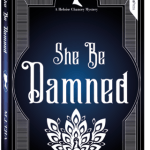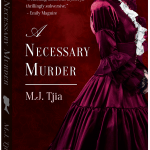Brisbane author M.J. Tjia talks to Sisters in Crime’s Vice-President, Robyn Walton, about her books She Be Damned (Pantera, 2017) and A Necessary Murder (Pantera, 2018)
Hello, M.J. Sisters in Crime Australia got to know you in 2017 when you won the History and Mystery category in our annual short story competition, the Scarlet Stiletto Awards. Readers now have two novels in your Heloise Chancey mystery series. How does it feel being the creator of an ongoing series?
I’m loving it. The third novel is coming out this October [2019] and, with each book, I’ve found I am getting to know and care about the characters more and more — both Heloise and Amah, but also the characters who surround them in each novel. I enjoy the space a series gives me as a writer to explore their lives.
 The dedication in your first novel, She Be Damned, reads: “For Mum, who introduced me to Christie, Marsh, Allingham and Sayers”. That’s self-explanatory, but would you like to say a little more?
The dedication in your first novel, She Be Damned, reads: “For Mum, who introduced me to Christie, Marsh, Allingham and Sayers”. That’s self-explanatory, but would you like to say a little more?
There’s something really gratifying about finding an author or a character you really love. Even better, when you find out you can pore over a whole series by that author or with that character. In the corridor between my parents’ room and the bathroom, there was a bookcase full of books by the authors I mentioned. How satisfying to plough through them all, book by book, curled up on the couch, perhaps with a packet of Twisties, if I was lucky. Now these books are akin to comfort food for me. And I still search second-hand bookshops, hoping for the whoosh of delight when I find one I haven’t read before.
You live in Queensland and set your novels in 1860s’ London. Where do you do your research? And where do you do your best writing?
Originally, I did visit London a couple of times in order to conduct research for the novels. I joined the British Library so I could read novels written in the 1860s that can no longer be borrowed, and I visited museums, such as the Victoria and Albert Museum or the Charles Dickens Museum, so that I could look at the apparel of the time and see how people lived. I also scoured London for the streets and restaurants and hotels mentioned in Victorian literature. Heloise is based on a courtesan of the time named Catherine Walters, and her house is on South Street (like Heloise’s) and it has a blue plaque out the front that says, Catherine Walters, (Skittles), The Last Victorian Courtesan, Lived here from 1872 until 1920.
For at least a year before I started writing She be Damned, I researched both novels and academic literature regarding Victorian London. I studied the social mores of the time, ideas of sexuality, courtesans and Victorian detective fiction written by women or with female protagonists. Writing She be Damned was part of my PhD project, in which I examined the female detective, sexuality and the Asian population of Victorian London.
For my creative writing and research, I mostly work at home, in my tiny office. I am far too distracted by others to work in a share office or library or café.
Heloise is 25 and has done a lot of living before we meet her. Can you tell us about Heloise’s backstory? How did you go about inventing this?
Because I always wanted these books to be part of a series, I have purposely drip-fed Heloise’s backstory to the reader, through both her memories and through Amah’s recollections. Mostly, I developed her backstory from what I have read of actual 19thcentury courtesans, and their experiences. In the third novel, The Death of Me, Amah finds herself back in Liverpool, and we learn a lot more of Heloise’s childhood. In future books we will find out more about how she came to be a sex-worker and how she fought her way to her relatively elevated position.
Heloise styles herself “the peacock of the night”. There is plenty to envy in her flamboyant lifestyle and exquisite wardrobe?
In the Victorian period, successful courtesans were akin to modern-day celebrities. They were written about in the newspaper and women copied their fashions. Heloise’s jewellery, fripperies and Worth gowns represent how far she has come in life: from a very poor background in Liverpool to the heights of London society (much like ‘Skittles’, whom she is based upon). However, I have tried to temper Heloise’s love of opulence with her awareness that she’s in a socially precarious position. She knows that to appear wealthy and relevant is crucial to her continuing success.
And she is also a paid investigator. How did she acquire this role?
When I was researching the Victorian female detective, I came across both fictional and documented literature regarding women of the time working as professional detectives. I think perhaps their main role was to spy; disguised as maids, nannies, seamstresses and so forth.
Heloise is very intelligent and lively. Once she acquired social stature and the comfort and stability this entailed, she sought excitement in other channels. She started out on small assignments for Sir Thomas, where she dabbled in disguise and subterfuge, until she progressed to investigating the more serious crimes explored in the novels.
Heloise’s maid, Li Leen, and other servants help her. I was reminded of Phryne Fisher’s household in Kerry Greenwood’s series, and perhaps Rowland Sinclair’s household in Sulari Gentill’s books. Did you set out to create an ensemble of supporting characters?
Originally, I think Amah was the only main supporting character. The other characters grew out of the first book. In fact, some recurring characters were thrown into the first book in order to be extra suspects. But over time I get to know the other characters and want to explore their backgrounds too. And obviously over a series of books they will become a part of Heloise’s life, but I haven’t yet decided on whether any of these characters will actually be involved in a case that Heloise needs to investigate.
The case we hear about in She Be Damned is shocking. Four women have been sexually mutilated and murdered in the city in the previous seven weeks, yet “the police don’t want to waste too much time investigating”. How is Heloise persuaded to become involved?
In a way, Heloise is coerced into taking the case — she has never investigated such a serious, violent crime before — and yet it’s not long before she becomes personally invested in finding out who is responsible for the murders. I realise the nature of the murders in She be Damned seems reminiscent of Jack the Ripper but, in reality, I developed the idea when reading about a certain Victorian doctor who performed genital mutilation on women without consulting them first. I have named him in the novel. What Heloise has to work out is if the murders are accidental deaths from such surgeries, or if someone is slaying sex workers on purpose.
Heloise moves into accommodation in a rough area, tones down her appearance, and starts investigating. How did you go about plotting what follows?
Well, in the beginning she is trying to track down Eleanor, the missing girl, so she tramps around all her old haunts. While searching for her, though, Heloise has the ability to explore possible murder suspects too, and she meets Sergeant Bill Chapman, a policeman. Along the way readers will learn quite a bit about the daily difficulties of being a sex worker or street kid in Victorian England.
What most stays in your mind from your research?
There are two sections in Henry Mayhew’s work, London Labor and the London Poor, which stay with me. One section details interviews with sex workers who either supplement their meagre earnings with prostitution or shun occupations such as being a seamstress or factory worker altogether because of the terribly long hours at a minimal wage.
As ‘Swindling Sally’, a 19th century prostitute, says: “How did I come to take to this sort of life? It’s easy to tell. I was a servant gal away down in Birmingham. I got tired of workin’ and slavin’ to make a livin’, and getting a bad one at that; what o’ five pun’ a year and yer grub, I’d sooner starve, I would” (Mayhew, p. 223).
Their frankness is refreshing. As Bernstein writes of these women in Victorian Vulgarity, “Well aware of the standards she violates, she has little regard for them, not does she soothe the sensibilities of her interviewer… with a token show of regret”.
The other section was an interview with a very poor, young boy (perhaps a gem collector, chimney sweep or mudlark?) which went much like Heloise’s exchange with Chat, where she asks him if he ever cries, and the boy says, “What’s the use?”
 In A Necessary Murder Li Leen takes an active role throughout, and some of the contemporary London criminality has links back to places and people in her South-East Asian youth. What gave you this idea for the novel?
In A Necessary Murder Li Leen takes an active role throughout, and some of the contemporary London criminality has links back to places and people in her South-East Asian youth. What gave you this idea for the novel?
This definitely came from my desire to write back against the trope of the ‘sinister Oriental’ that is so prevalent in Victorian and crime fiction — such as found in Fu Manchu novels and even in Dickens’ and Conan Doyle’s works. There is some academic literature that explores how inaccurate these portrayals are of the Asian occupants of London, and how this kind of caricature emerged from racist ideals. I undertook a lot of research into the very small population of Asians in Victorian London, and in that research I found references to the Strangers House, a burgeoning Limehouse, and lodging houses for Indian nannies and servants.
I find it fascinating that so long ago many people travelled long distances to settle somewhere so different from their own lands. How did they find themselves in London? Did they want to settle there, or were they simply stuck there? In my Heloise novels, I want to explore the more everyday lives of Asians in Victorian London —what they ate, how they made a living, where they resided — as distinct from the imagined insidious, criminal ‘sinister Orientals’.
Have you had reader feedback about the increased “exotic” content? Are we likely to go on finding Asian characters, culture and food in the Heloise mysteries?
Ed Wright wrote a lovely review of my second novel for The Weekend Australian: Review, in which he states, “The London she presents is multi-layered and multicultural, not surprising given it was the capital of a massive empire, yet not a reality to be found even in someone as interested in the down and out as Dickens. … Tjia’s evocation of the past in A Necessary Murder makes a political point”. This review exactly encapsulates what I try to achieve in writing my Heloise series — that the books read as spicy romps which are bolstered by serious themes. Also, because Heloise and Amah are each Eurasian, Asian aspects will definitely continue in the series, but to varying degrees depending on the plot.
Energetic, hearty Englishmen distinguished in the sciences, medicine, archaeology and exploration meet in Heloise’s drawing room. She says she finds them attractive, but is she obliged to be charming to them?
Heloise is pragmatic about what is socially required of her for her continued success as a courtesan, which, after all, is how she makes a living for herself and for her household. I think she’s strategic in who she knows and who she’s pleasant to. However, these soirees are more for her own enjoyment and intellectual stimulation and she chooses who she surrounds herself with.
What kinds of things did you learn when you investigated London society’s child-rearing and adoption practices?
I’ve always been fascinated with baby farmers, since watching a BBC documentary about them years ago. I’m interested in the state of a society that necessitates such a profession. Although I’m sure there were compassionate, genuine carers for illegitimate babies, what fascinates me is the absolute cold-heartedness of the baby farmers who allowed children to die in their care (or who actually murdered them). Also, imagine the terrible wrench many of the mothers would have felt being parted from their babies because they simply had no other options. Life was very harsh indeed for these women.
The last word goes to you, M.J. Is there anything more you’d like to tell us about your writing life or the Heloise Chancey mystery series?
I always meant for the Heloise Chancey novels to be part of a series. I wanted each story to be a standalone murder mystery while, in the background, we find out more about Heloise and Amah. Also, although these books are supposed to be read as fun romps, I do like to touch upon serious themes to do with gender and race. Hopefully readers come to love Heloise and Amah as much as I do.
Click here for more info.
